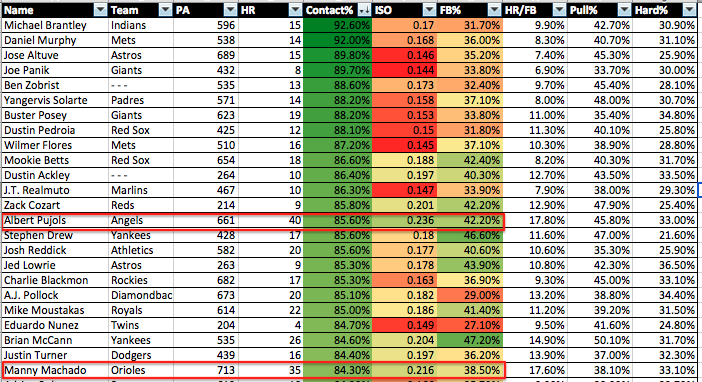RotoAcademy Preview: Contact Might Be Important
Contact + Power + Fly Balls = Home Runs
The baseball cliché about hitting a round ball with a round bat gets thrown around all the time when arguing about the level of difficulty across various sports. The reality is that it is extremely hard to hit a baseball and it is becoming even harder with the increase in velocities and overall stuff of major league pitchers. Pitchers are now rewarded for maximum velocity/effort and strikeout totals. Clubs and managers care less and less about the number of innings pitched, because of the way bullpens are used. They would rather have their starter go all out for five to six innings and turn it over to the bullpen than have their starter labor through eight. This has led to increased strikeouts across the league.
This has also put an emphasis on hitters with power. Clubs are beginning to value the ability to get on base and hit for power from their hitters. Strikeouts are no longer limiting factors for managers and clubs (think Miguel Sano, Chris Davis, and Chris Carter).
Now how does that apply to DFS and projecting power? For starters, power is scarce across the league, which makes it even more of an edge if you can project it better than your opponents on a nightly basis.
Secondly, we can mimic and piggy-back off of what teams are looking for when trying to identify power hitters: contact (K%), power (ISO), and fly-balls (FB%).
In this lesson we are going to examine the importance of contact in projecting home runs, because you need to make contact with the ball to hit it out of the park. If a player cannot do this consistently enough, they will never put themselves in the position to hit a home run.
Editor’s Note: This is one of the many valuable DFS lessons that can be found over at RotoAcademy. Click here to browse through all of our free/premium offerings and improve as a daily fantasy sports player!
Using K%
You will want use K% as a quick and easy way to identify the players that are making more contact than others. Let’s look at two players from a year ago.
Player A: 35 HR / .216 ISO / 39% FB
Player B: 29 HR / .213 ISO / 45% FB
How did Player B end up with fewer home runs than Player A if they hit a higher percentage of fly balls? It comes down to contact – Player A struck out 16% of the time and Player B struck out 31% of the time. Quite simply, Player A hit more fly balls, because he made more contact.
— Player A was Manny Machado and Player B was Kris Bryant. Without looking who would you have said had more power?

The importance of making contact is underrated when it comes to power hitters. There are guys who thrive with low contact rates (Chris Davis, Miguel Sano, and Kris Bryant), but if all things are equal you want to roster the guy that is going to make more contact, because that will give you a better chance at your desired outcome – a home run.
In the chart above I sorted by highest contact rates. You can see that a lot of the top contact guys do not have a ton of power (ISO) or hit a lot of fly balls. However, the guys (Pujols and Machado) that combine contact, power, and fly balls posted excellent home run totals.
Summary: Guys like Albert Pujols, Manny Machado, and Anthony Rizzo combine great contact skills with power. As seen above, high contact rates typically don’t equate to high home run totals, but it is an important factor to consider when projecting home runs and, more importantly, home run growth.
In How To Profit by Better Projecting Home Runs, you’ll learn:
• What basic stats matter the most for predicting home runs
• Why contact percentage and fly-ball rates are an important foundation for power hitters
• Which advanced stats matter for home runs
• What contextual factors like weather and park factors matter for power hitting
• How to apply all the information into daily predicting home runs more accurately
To read the rest of ‘How To Profit by Better Projecting Home Runs’, you must purchase the course!
